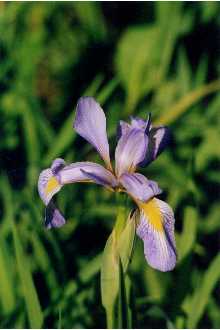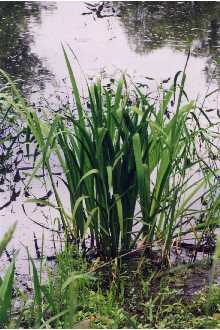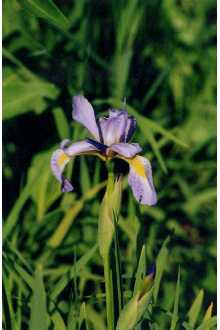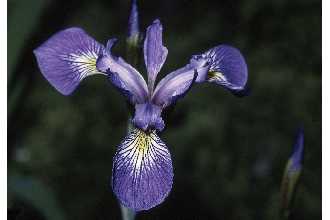Virginia Iris
Scientific Name: Iris virginica L.

| General Information | |
|---|---|
| Usda Symbol | IRVI |
| Group | Monocot |
| Life Cycle | Perennial |
| Growth Habits | Forb/herb |
| Native Locations | IRVI |
Plant Guide
Alternate Names
Blue flag, southern blue flag, blue iris Warning: The roots of Virginia iris are toxic when taken internally, without sufficient preparation.
Uses
Ethnobotanic: The Cherokee and other tribes in the southeastern United States are known to have used Virginia iris for its medicinal properties. The root was pounded into a paste that was used as a salve for skin. An infusion made from the root was used to treat ailments of the liver, and a decoction of root was used to treat “yellowish urine.” Virginia iris may have been one of the iris species used by the Seminole to treat “shock following alligator-bite.”
Status
Please consult the PLANTS Web site and your State Department of Natural Resources for this plant’s current status (e.g. threatened or endangered species, state noxious status, and wetland indicator values). ©William S. Justice @ PLANTS
Description
General: Iris Family (Iridaceae). Virginia iris is a perennial plant. The slightly fragrant flowers (4 cm long, 7 cm across) consist of 3 horizontal sepals, or “falls,” and 3 erect petals. The petals and sepals can vary in color from dark-violet to pinkish-white. The sepals have a splash of yellow to yellow-orange at the crest. Each plant has 2 to 6 flowers that bloom from April to May upon a single, erect, 3-9 dm tall stalk. The stalk is sometimes branched and has a slight zigzag appearance. The plant has 2 to 4 erect or arching, bright green, lance-shaped leaves that are flattened into one plane at the base. Leaves are 1 – 3 cm wide and are sometimes longer than the flower stalk. The fleshy roots (1-2 cm in diameter) are rhizomes that spread underground. Pale brown, variably shaped seeds are born in three-part fruit capsules (3-6 cm long, 1-2 cm wide). Distribution: Virginia iris is common along the coastal plain from Florida to Georgia. For current distribution, please consult the Plant Profile page for this species on the PLANTS Web site.
Adaptation
This plant grows in wet areas and sometimes in shallow water in both fresh and brackish tidal marshes. It can be found in low savannas, thin woods and open meadows as well as along the edges of swamps, rivers, and ditches.
Establishment
Virginia iris is a sturdy plant that is easy to grow and, once established, needs very little care. They make lovely additions to the garden and are ideal for the borders of a garden pond. This is because the plants prefer moist to wet soils that are high in organic matter. The plants will grow best in mild climates where they can be grown in partial shade to full sun. The plants can be grown from seed, but are easiest to propagate through division. Seeds may be planted in the autumn, without pretreatment. To propagate by division, divide the plants either after flowering or when the new leaves just begin to appear in the spring. Cut the roots so that each piece contains a portion the feeding roots, the rhizome, and a leaf fan. Place the rhizomes very near to the surface of the soil when planting. Allow 45 to 60 cm between plants. The plants grow best if divided every three to five years to thin out the colonies that form.
Pests and Potential Problems
Snails are known to eat the leaves. Cultivars, Improved, and Selected Materials (and area of origin) These plant materials are readily available from commercial sources. Contact your local Natural Resources Conservation Service (formerly Soil Conservation Service) office for more information. Look in the phone book under ”United States Government.” The Natural Resources
Conservation
Service will be listed under the subheading “Department of Agriculture,” , Use soil moisture sensors to measure the soil moisture of Virginia Iris.
Plant Traits
Growth Requirements
| Moisture Use | High |
|---|---|
| Adapted to Coarse Textured Soils | No |
| Adapted to Fine Textured Soils | Yes |
| Adapted to Medium Textured Soils | Yes |
| Anaerobic Tolerance | High |
| CaCO3 Tolerance | Low |
| Cold Stratification Required | No |
| Drought Tolerance | None |
| Fertility Requirement | Medium |
| Fire Tolerance | None |
| Frost Free Days, Minimum | 200 |
| Hedge Tolerance | None |
| pH, Maximum | 7.3 |
| pH, Minimum | 4.8 |
| Planting Density per Acre, Maxim | 10912 |
| Planting Density per Acre, Minim | 2728 |
| Precipitation, Maximum | 65 |
| Precipitation, Minimum | 45 |
| Root Depth, Minimum (inches) | 6 |
| Salinity Tolerance | None |
| Shade Tolerance | Tolerant |
| Temperature, Minimum (°F) | 12 |
Morphology/Physiology
| Bloat | None |
|---|---|
| Shape and Orientation | Erect |
| Toxicity | None |
| Active Growth Period | Spring |
| Coppice Potential | No |
| Fall Conspicuous | No |
| Fire Resistant | No |
| Flower Color | Blue |
| Flower Conspicuous | Yes |
| Foliage Color | Green |
| Foliage Porosity Summer | Porous |
| Foliage Porosity Winter | Porous |
| Foliage Texture | Coarse |
| Fruit/Seed Conspicuous | No |
| Resprout Ability | No |
| Nitrogen Fixation | None |
| Low Growing Grass | No |
| Lifespan | Moderate |
| Leaf Retention | No |
| Known Allelopath | No |
| Height, Mature (feet) | 3.3 |
| Growth Rate | Moderate |
| Growth Form | Rhizomatous |
| Fruit/Seed Color | Black |
Reproduction
| Vegetative Spread Rate | Moderate |
|---|---|
| Small Grain | No |
| Seedling Vigor | Medium |
| Seed Spread Rate | Slow |
| Fruit/Seed Period End | Fall |
| Propagated by Tubers | No |
| Propagated by Sprigs | No |
| Propagated by Sod | No |
| Propagated by Seed | Yes |
| Propagated by Cuttings | No |
| Propagated by Container | No |
| Propagated by Bulb | Yes |
| Propagated by Bare Root | No |
| Fruit/Seed Persistence | No |
| Fruit/Seed Period Begin | Summer |
| Fruit/Seed Abundance | Low |
| Commercial Availability | Routinely Available |
| Bloom Period | Spring |
| Propagated by Corm | No |
Suitability/Use
| Veneer Product | No |
|---|---|
| Pulpwood Product | No |
| Post Product | No |
| Palatable Human | No |
| Palatable Graze Animal | Low |
| Palatable Browse Animal | Low |
| Nursery Stock Product | Yes |
| Naval Store Product | No |
| Lumber Product | No |
| Fodder Product | No |
| Christmas Tree Product | No |
| Berry/Nut/Seed Product | No |




